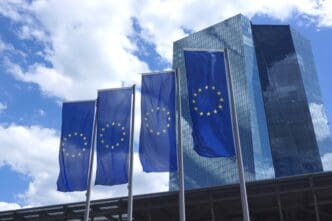Executive Summary
The Story So Far
Why This Matters
Who Thinks What?
“`html
The European Central Bank (ECB) opted to maintain its interest rates at 2% for the third consecutive meeting on Thursday, October 30, in Florence, Italy. President Christine Lagarde indicated the central bank is in a “good place” regarding monetary policy, citing receding economic risks and the euro zone’s resilience amidst global uncertainties. This decision follows a period where the ECB had cut rates by 2 percentage points leading up to June.
Monetary Policy Stance and Economic Outlook
Lagarde underscored that while the current policy stance is favorable, it is not immutable. She highlighted several factors mitigating downside risks to growth, including a trade agreement between Europe and the United States, a Gaza ceasefire, and an agreement between President Donald Trump and China’s Xi Jinping to reduce tariffs. Despite this, the growth outlook remains modest due to tariffs and Chinese dumping practices.
The euro zone’s economy expanded by 0.2% in the third quarter, surpassing both market and ECB projections. Lagarde expressed satisfaction with this performance, noting she would not “complain” about the growth rate. However, she indicated that while growth risks have abated, inflation risks remain more balanced, with the ECB anticipating inflation to undershoot its target next year.
Inflation Projections and Internal Debates
The ECB is set to release its first projections for 2028 in December. Sources suggest that clear evidence of persistent inflation undershooting in these long-term forecasts could prompt a debate on rate cuts during the upcoming meeting. However, other policymakers reportedly view long-term projections with caution, arguing that a modest undershooting of 20 or 30 basis points could be tolerated.
Financial markets largely maintained their outlook, with a 40% to 50% probability of one final rate cut by mid-next year. Nordea economist Jan von Gerich commented that the ECB is “nowhere near any rate changes” and does not anticipate adjustments for a considerable period, despite existing risks.
Mixed Economic Signals and Future Considerations
Data signals present a mixed economic picture. Upcoming changes to the EU’s ETS2 emissions trading system could influence inflation, potentially adding 0.3 percentage points to 2027 inflation, though the EU is considering a smoother, two-year introduction. A stronger euro, which reduces import prices, or supply chain disruptions could also impact the economic landscape.
Recent economic activity data have generally surprised on the upside, with Spain and France outperforming in the third quarter. Early fourth-quarter indicators, such as an accelerating Purchasing Managers’ Index and improving German sentiment, suggest potential growth. Conversely, industrial activity continues to suffer, exports to the United States are down, and there are indications of China redirecting goods from the U.S. to European markets.
ECB Chief Economist Philip Lane has suggested that an undershooting risk for inflation would strengthen the case for a “slightly lower” policy rate. Nevertheless, most economists anticipate rates will remain stable, citing fading uncertainty, household savings, and increased German government spending. Commerzbank economist Jörg Krämer reinforced this view, stating that an unchanged deposit rate of 2.0% remains the most probable scenario, given the high hurdle for the ECB to raise rates.
“`








